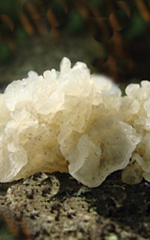
Tremella Mushrooms (Tremella fuciformis)
 Tremella Mushrooms (Tremella fuciformis)
Tremella Mushrooms (Tremella fuciformis)
Women’s aid for beauty from the Inside, Out.
Tremella Mushroom (Tremella fuciformis), also called Silver Ear Mushroom with its large loose lobes, has been used in Asia as a Qi and immune tonic. Tremella has been also highly prized as a youthful skin tonic for a healthy complexion. It is said that imperial Concubine Yang (719-756), considered to be one of the most beautiful women in Chinese history, used Tremella for her facial and body maintenance. As such, Chinese women have been taking Tremella traditionally to make the skin moist, soft and pliable. According to traditional Chinese medicine Tremella nourishes the lung, stomach and kidney, strengthens the bones, helps maintain ideal weight and provides proper moisturization to the skin which belongs to the lung network. Tremella contains rich dietary fibers and Vitamin D, and modern research indicates Tremella’s usefulness as an anti-tumor agent in lowering blood glucose, lowering cholesterol, and protecting against radiation as well.
Bioactive constituents:
Glucuronoxylomannan, Vitamin D
Bioactivities:
• Anti-hyperlipidemia: Inhibits cholesterol absorption from the intestine / Reduces cholesterol levels in serum and liver / Prevents arteriosclerosis
• Anti-diabetes: Improves the secretion of insulin by recovering damaged beta-cells in pancreatic polypeptide / Promotes the absorption of glucose in liver and inhibits the release of glucose from liver by increasing the hexokinase activity and reducing glucose-6-phosphatase activity
• Anti-tumor effect: Enhances immune system / Enhances effects of Mitomycin C (glucuronoxylomannan)
• Anti-osteoporosis: Enhances calcium absorption
• Hepatoprotection: Promotes metabolism of protein and nucleic acid in liver
References:
(1) S. Ukai et al, Chem. Pharm. Bull., 20:2293 (1972); 22:1105 (1974); 26:3871 (1978)
(2) M. Kakuta et al, Agric. Biol. Chem., 43:1659 (1979)
(3) T. Kiho et al, Chem. Pharm. Bull., 29:225 (1981)
(4) K. Hashimoto et al, Abstract of the 43rd Meeting of Japan Nutrition and Food Sci., 155 (1989)
(5) K. Komae et al, Agric. Biol. Chem., 53:1237 (1989)
(6) S. Ukai et al, Yakugaku Zasshi (Japanese), 112(9):663 (1992)
(7) K. Sugiyama et al, Nippon Eiyo Shokuryo Gakkaishi, 45(3):265 (1992)
(8) T. Kiho et al, Yakugaku Zasshi (Japanese), 114(5):308 (1994)
(9) A. Misaki et al, Food Review International, 11(1) :211 (1995)














